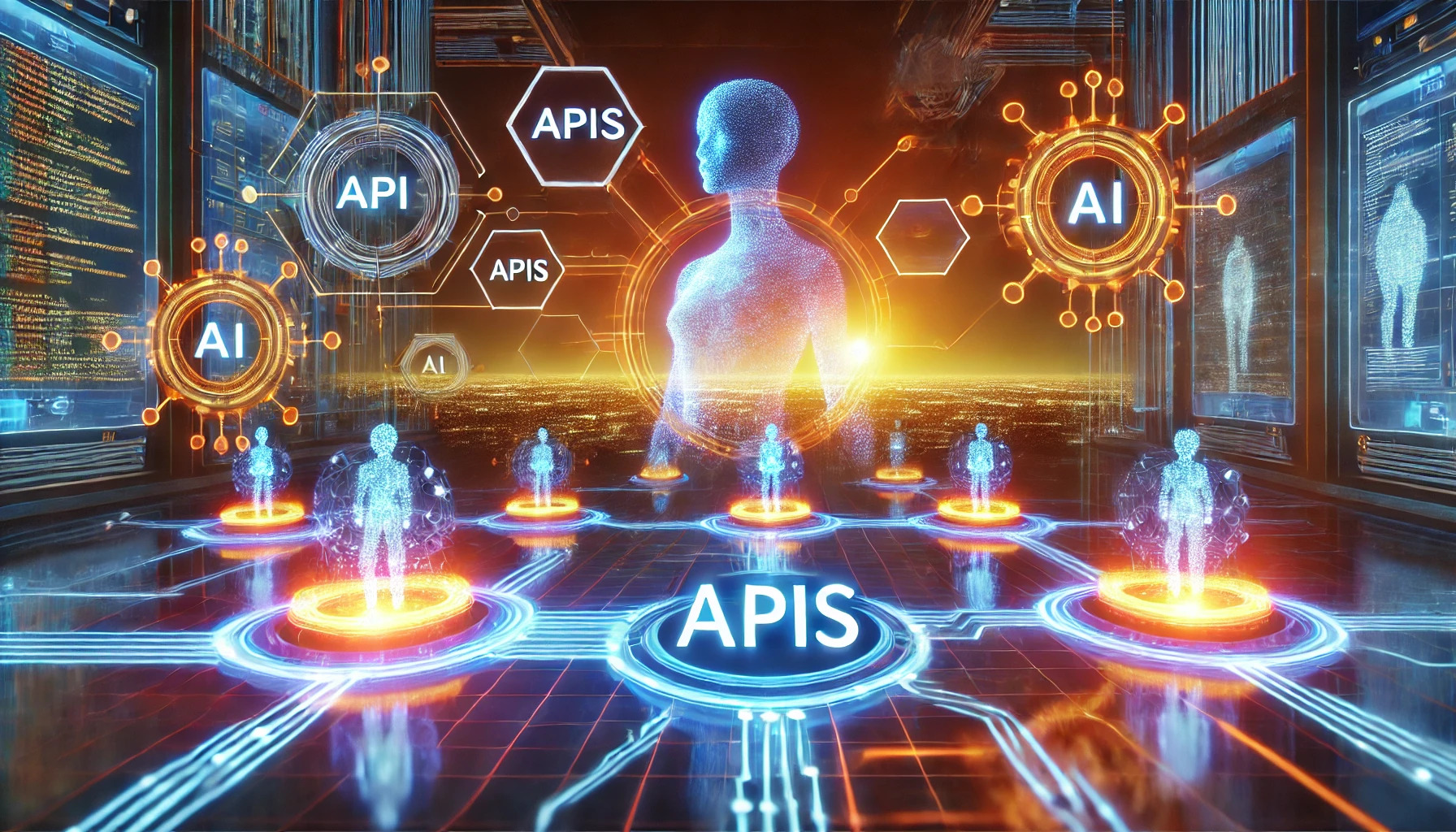APIs For The AI Agent Age
February 12, 2025 • AI
Let’s talk about APIs (Application Programming Interfaces). These are the bridges that let different software talk to each other. In the world of AI agents, these bridges are becoming more flexible, dynamic, and—most importantly—temporary. Think of it as moving from a fixed bridge to a rope bridge you can set up and take down as needed.

Thanks, for sharing:
Traditional vs. AI Agent APIs
Traditional APIs are like old-school phone lines. They’re stable, predictable, and designed for ongoing, fixed connections. But with AI agents, we’re entering an era where connections might only need to exist for a few minutes or hours. Imagine a travel app connecting to a flight database to book a ticket—it only needs that connection briefly, but it has to work seamlessly.
In traditional software development, APIs (Application Programming Interfaces) have typically been designed as fixed, persistent connections between systems. They're documented meticulously, versioned carefully, and maintained for extended periods to ensure stability for the developers and applications that depend on them. However, as we enter the age of AI agents, this longstanding approach to API design and implementation is undergoing a fascinating transformation.
The Shift to Temporary, Flexible Connections
Agentic AI integrations will not be fixed or unchanging anymore. Instead, more temporary, flexible connections may become the standard. AI agents thrive on adaptability. Here’s why flexible APIs are a game-changer:
Real-Time Needs: An AI agent handling logistics might need to connect with dozens of systems on the fly—from weather updates to traffic data.
Scalability: Temporary APIs mean you’re not overloading systems with constant connections.
Cost-Efficiency: Why pay for a connection you don’t need 24/7? Flexible APIs cut down on unnecessary resource usage.
This shift is being driven by several key factors:
Dynamic Task Execution
AI agents are designed to accomplish tasks dynamically, often without human intervention. Unlike traditional software that follows predetermined paths, AI agents adapt their approach based on the specific task at hand. This requires APIs that can be discovered, engaged with, and disconnected on the fly.
When an AI agent needs to perform a task like "book a restaurant reservation," it might need to:
Discover relevant booking APIs
Understand their parameters and requirements
Connect temporarily to accomplish the task
Disconnect once complete
This process happens autonomously, without a developer hard-coding these connections in advance.
Context-Aware Integration
AI agents understand context in ways traditional software cannot. They can interpret user intent, adapt to situational factors, and select the most appropriate service for a specific need. APIs in the agent age need to provide rich contextual information about their capabilities and constraints, allowing agents to make intelligent decisions about when and how to use them.
For example:
An agent planning a trip might choose different transport booking APIs based on user preferences, current weather conditions, or local events.
A document processing agent might select different PDF manipulation APIs based on the specific transformations needed for a particular document.
Ephemeral Connections
Many AI agent interactions will be ephemeral—created for a specific task and then discarded. This contrasts sharply with traditional API integrations, which are typically established during development and maintained throughout an application's lifecycle.
These ephemeral connections require:
Lightweight authentication methods
Minimal setup overhead
Clear, self-documenting interfaces
Graceful disconnection patterns
Implications for API Design
This shift has profound implications for how we design and implement APIs in the AI agent age:
Self-Describing Interfaces
APIs need to become more self-descriptive, with rich metadata that explains:
What capabilities they offer
What parameters they accept
What constraints they operate under
How their outputs should be interpreted
OpenAPI specifications and JSON Schema are becoming increasingly important, but we'll likely see these standards evolve to include agent-specific metadata.
Function-Calling Standards
Standardised function-calling interfaces are emerging to help agents understand how to interact with APIs. These provide structured ways for agents to:
Discover available functions
Understand parameter requirements
Format requests properly
Parse responses consistently
Frameworks like OpenAI's Function Calling API and Anthropic's Tool Use features are early examples of these standards.
Semantic Reasoning
APIs will increasingly leverage semantic annotations to help agents reason about their capabilities. This might include:
Ontology references that map API functions to real-world concepts
Relationship definitions between different parameters
Constraint specifications that help agents understand limitations
These semantic layers will help agents make better decisions about which APIs to use for specific tasks.
Authentication and Security Challenges
The shift to more dynamic, ephemeral connections raises important security questions:
How do we authenticate agents securely for short-lived connections?
How do we authorize agents to act on behalf of users?
How do we establish appropriate rate limits and quotas?
How do we audit agent actions across multiple services?
OAuth flows, API keys, and session-based authentication will need to evolve to accommodate agent-based integration patterns.
Real-World Examples Emerging Today
We're already seeing examples of this shift in practice:
Plugin Ecosystems
AI platforms like ChatGPT with plugins provide early examples of agent-API integration. These plugins:
Register their capabilities with the AI system
Provide standardized interface descriptions
Allow the AI to dynamically choose which plugin to use based on user needs
Tool Use Frameworks
LLM frameworks that support "tool use" enable models to:
Recognize when external tools are needed
Format requests to those tools appropriately
Incorporate tool responses into their reasoning
LangChain and Similar Frameworks
Tools like LangChain provide abstraction layers for connecting AI agents to various external systems, creating standardized interfaces for previously disparate services.
Challenges and Considerations
This shift to more flexible, ephemeral API connections isn't without challenges:
Standardization Needs
For AI agents to effectively discover and use APIs, we need stronger standards around:
Capability description
Parameter specification
Response formatting
Error handling
Trust and Verification
When agents autonomously discover and connect to services:
How do we verify service quality?
How do we prevent malicious services?
How do we ensure user data is handled appropriately?
Debugging Complexity
When connections are established dynamically:
How do developers debug integration issues?
How do we trace requests across multiple ephemeral connections?
How do we monitor performance and reliability?
Building APIs for the Future
Creating APIs that cater to the AI agent age isn’t about reinventing the wheel—it’s about adding some serious upgrades. Here’s how:
Event-Driven Architecture
Why It’s Important: Traditional APIs rely on constant polling for data. Event-driven APIs only activate when a specific trigger occurs, saving resources.
How to Use It: An e-commerce AI agent could use event-driven APIs to restock items when inventory falls below a threshold or notify customers about flash sales in real time.
Standardization
Why It’s Important: With so many systems interacting, a common language ensures smoother communication.
How to Use It: Standardized formats like JSON or RESTful APIs make it easier to integrate third-party services, like syncing product catalogs with marketplaces or shipping platforms.
Security
Why It’s Important: Temporary connections still involve sensitive data. Without robust security, the system becomes vulnerable to breaches.
How to Use It: Authentication protocols (e.g., OAuth) and data encryption ensure that customer data, such as payment information, remains private.
Examples in Action
Dynamic Task Management: A virtual assistant organising an event could temporarily connect to a catering database, venue booking system, and guest list platform.
E-commerce Automation: An AI agent in an online store could analyse customer preferences, update pricing dynamically, and provide personalised recommendations through APIs connecting inventory, sales analytics, and customer data.
Emergency Response: In a natural disaster, AI agents could use APIs to pull data from government systems, weather satellites, and local resources to coordinate aid.
The Road Ahead
We’re moving into a world where APIs will need to:
Think fast: Adapt to rapidly changing conditions.
Stay flexible: Work across different systems, even if they weren’t originally designed to connect.
Play nice with AI: Provide the data and functionality AI agents need to make smart decisions.
In short, APIs are becoming less like fixed highways and more like on-demand ride-shares—there when you need them, gone when you don’t. It’s an exciting shift, and it’s one that will define how AI agents integrate into our daily lives.
So, whether you’re a developer, a business owner, or just an AI enthusiast, it’s time to think about APIs in a whole new way. They’re not just tools anymore—they’re the glue that’s going to hold the AI agent age together.
The rise of AI agents is fundamentally changing how we think about API design and integration. Rather than static, developer-defined connections, we're moving toward dynamic, agent-discovered integrations that form and dissolve as needed.
This shift requires us to rethink fundamental aspects of API design, authentication, discovery, and monitoring. The APIs of the AI agent age will be more semantic, more self-describing, and more dynamic than their predecessors.
For developers and organizations building APIs today, adapting to this new paradigm means:
Enriching API documentation with machine-readable semantics
Designing for ephemeral connections rather than just persistent ones
Considering how agents (not just human developers) will discover and understand your services
Building more flexible authentication and authorization mechanisms
Those who embrace these changes will find their services more accessible to the growing ecosystem of AI agents, potentially opening new channels for service discovery and utilization.
Thanks, for sharing:

